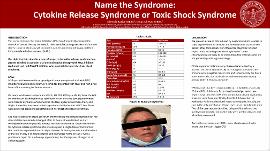| dc.description.abstract | Introduction: The use of immune checkpoint inhibitors (ICIs) has dramatically changed the outlook of cancer therapy. As a result, their use is becoming prevalent and a more diverse range of clinicians will encounter patients on immunotherapy and their immune-related adverse events (irAEs). Our objective is to describe a case of suspected cytokine release storm in a patient enrolled in a phase I trial on combination therapy with PDL1 inhibitor Avelumab and oral DNA PK inhibitor who was initially treated as toxic shock syndrome.
Case: A 38 year-old-woman with an ependymal tumor on a phase I trial with PDL1 Inhibitor Avelumab and oral DNA PK inhibitor presented with fever and rash a few hours after receiving Avelumab infusion. On exam, vitals were Temperature 39.2 C, HR 148, BP 87/45, RR 30, Pulse Ox 98% on ambient air. Examination was significant for an alert and conversant woman with macular erythema which involved the face, upper extremities, chest, and thighs. Indwelling lines were noted: a peritoneal catheter and a PICC line. There were scattered areas of desquamation on her chest and upper extremities. She was treated with broad-spectrum antimicrobials including clindamycin but her clinical status remained unchanged after 12 hours. It was decided to start methylprednisone for a possible adverse reaction to Avelumab. Given the concern for cytokine release syndrome, she was also given a single dose of Tocilizumab 800mg. Her condition improved dramatically in the next 24 hours; she was transferred out of the ICU on Day 3 of hospitalization and discharged home on Day 7 with a prednisone taper. On a follow-up appointment, her therapy was changed to an alkylating agent.
Discussion: We present a case of CRS induced by Avelumab which resulted in rapid improvement of the rash and hemodynamic status of the patient after Tociluzimab. Our differential diagnosis included septic shock, including toxic shock syndrome. These circumstances are likely to be encountered by clinicians who are not primarily practicing in oncology.CRS is a systemic inflammatory disease characterized by a massive release of cytokines. By increasing the activity of the immune system against cancer cells and subsequently the host’s non-cancer cells, ICIs can lead to cytokine-mediated toxicity among which IL-6 plays a key role. CRS has now also been recognized to occur with ICIs, especially PD1 and PDL1 inhibitors. To our best knowledge, seven case reports have described CRS after pembrolizumab and nivolumab; however, none have specifically described this reaction to Avelumab. Rash was described in two case reports. Notably, our case is the only one that an ICI was used for an ependymal tumor. Two of the case reports described using tocilizumab and two used Mycophenolate. Corticosteroids were used in all cases and all patients recovered. Due to the increasing use of ICIs, more clinicians need to be aware that they can trigger CRS. | en_US |

